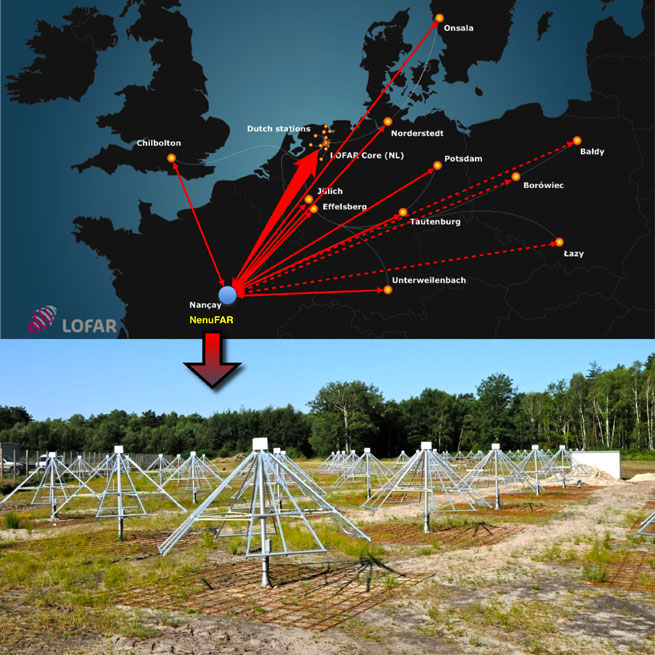The construction of NenuFAR has started at the Nançay station (in the Cher region). The first tranche (roughly a quarter of the final instrument) will be inaugurated in a year.
NenuFAR is an extension of the LOFAR array (Low Frequency Array), a major european array of low frequency antennas (see the insert).

NenuFAR is an array of antennas, and as such is very different from an « ordinary » radiotelescope (usually made up of a parabolic or spherical mirror). The receiver antennas look rather like TV antennas.
Ultimately, NenuFAR will have 1710 antennes, spread out within a 400 m diameter circular area. They are arranged in groups at ground level, and are linked electrically.
Each antenna « sees » the whole sky. The signals from these antenna groups are then digitized and combined using a computer. Through this procedure, it is possible to synthesize one or more narrow and sensitive beams, in any desired direction, without recourse to any mechanical motions. Pointing is thus fast, reliable, and can be in several directions at once if necessary. Since there are very many antennas the instrument is very sensitive within its very wide frequency range.
Since the signals from these antennas will be combined and treated in a dedicated electronic unit, NenuFAR will be able to function as two independent and simultaneous operating instruments :
- as an extension of the European LOFAR radioastronomical array, whose performance will thereby be considerably enhanced,
- and as a major stand-alone instrument, whose unique characteristics will enable the pursuit of an original scientific programme.
Scientific objectives
This new generation radiotelescope will enable one to attack a very wide range of subjects, as for example the evolution of the Universe during its « dark ages » (several million years after the Big Bang), the formation of galaxies and clusters of galaxies, pulsars and other transient sources, the Sun, planets and exoplanets...
A certified project
NenuFAR has already been certified as a « Pathfinder » project for the major international radioastronomical SKA (Square Kilometre Array) project.
SKA is a major radioastronomical project for the XXIst century, acknowledged as a world priority by the radioastronomical community. It will be built during the coming decade in South Africa and Australia by an international collaboration ; it will be a huge instrument made up of an array of radioantennas which together will be equivalent to a 1 kilometre square dish (many square kilometres in the lower frequency range).
As a proof of concept instrument, NenuFAR will be an invaluable source of information for the development and use of the low frequency part of SKA during the coming decade. This certification constitutes a veritable recognition of French scientific and technological know-how in radioastronomy, and emphasizes the promise and world-wide impact of NenuFAR.
Finance
The construction of NenuFAR has so far been financed essentilally by regional funding : the Région Centre (the Academic Initiative program - programme d’Initiative Académique) and the Région Ile de France (Domaine d’intérêt majeur « Astrophysique et Conditions d’Apparition de la Vie »).
Encadré
| LOFAR is a Europe-wide radioastronomical array centred in the Netherlands. It is made up of tens of thousands of antennas distributed over more than fifty stations, including one at Nançay. Their output is sent over a very high speed link to Gröningen where the data are combined in a super-computer to give the equivalent of a giant antenna with a heretofore unequalled perfomance. |


